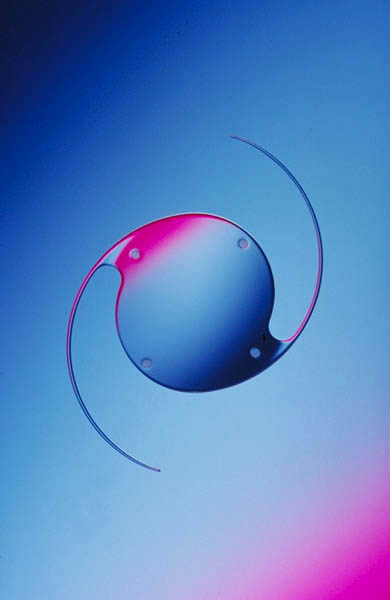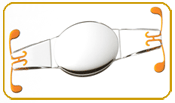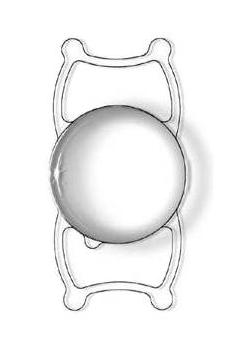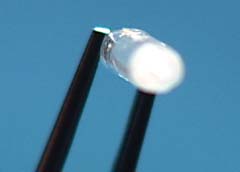Intraocular Lenses
Because the silicone and acrylic lens implant of traditional IOL (intraocular lenses) have only one focal length, the efforts of the cilliary body to refocus the lens have no effect. These are called fixed focus monofocal lenses, and they are what the vast majority of patients recieve. After cateract surgery, a patient needs to use distance glasses to see either distances further than that one focal length, and reading glasses to see closer. Photo: Stan Sholik |
 |
Accomodating Monofocal Intraocular Lenses
By fastening the IOL to the ciliary body, and making it from a material which can change focal length with shape or position, the need for glasses after cataract surgery can be reduced. This is called accommodation. Although they are called monofocal, standard IOL will exhibit slight accommodation. Several IOL have been designed to specifically exploit this concept.
Crystalens
 |
Crystalens, from Eyeonics in Aliso Viejo, CA The wings on the side are hinged haptic anchors, the lens is made from silicone. |
The Crystalens IOL has been shown to give 90% of patients implanted had a near visual acuity of J3 or better, while only 15% of patients with a fixed focus IOL had that vision. This is a promising result, although near visual acuity is not as much of a challenge as distant visual acuity. For near visual acuity, the measurement is done at 14", while for distant visual acuity, the measurement is done at 20'. Intermediate and distance vision were improved, but not enough to do away with glasses.
 |
|---|
| Macsai 2006 doi:10.1016/j.jcrs.2006.01.027 |
The procedure costs about $4,500 per eye, compared to $1,600 for ordinary cataract surgery. This is the only FDA approved accomodating lens, but there are other technologies available.
Kellan Tetraflex KH-3500
Lenstec, an IOL maker in Florida, made another accomodating lens, comparable in price to Crystalens. It has been used in Europe and the Middle East. A study published by the British Journal of Opthamology was unenthusiastic about the product, (though less connected to the manufacturer than the above Crystalens study), particularly due to the stiffening of the lens's response at six months, while Crystalens remains flexible for at least 3 years.
 |
At the sides you can see flexible haptic anchors, which allow the lens to move forwards and backwards as a whole. This changes the distance to the retina, as well as focal length. |
SmartIOL
SmartIOL from Medennium, Inc., in Irvine, CA, consists only of a full-sized, 9.5-mm diameter by 3.5-mm optic made of a thermodynamic, hydrophobic acrylic material

Other technologies in the works include the Sarfarazi Twin-Optic Elliptical Accommodating IOL, from Bausch and Lomb Rochester NY Quest Vision Technologies in Tiburon, CA, and reasearch from Advanced Medical Optics, Inc. Santa Ana, CA.